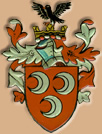 |
 |
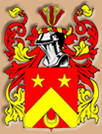 |
|||||||||
Bonnell Ranch, Glencoe, Lincoln County, New Mexico
Photo courtesy of Charles Bunnell |
|||||||||||
|
|||||||||||
L to R Archie Bonnell, His Son Charles Robert Bonnell, called Bobby (Tim’s Father) and Bert J Bonnell during a trip to Kansas. Archie and Bert were half-brothers. |
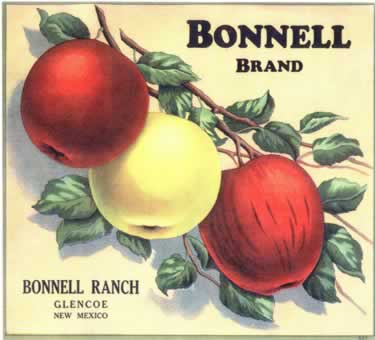 |
||||||||||
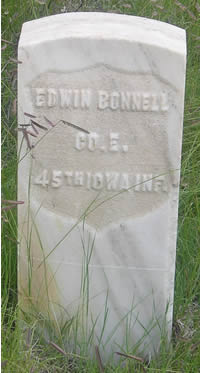 |
Above, the Bonnell Brand Apple Box Label from the Ranch Left, Edwin R Bonnell’s Headstone at Cedarvale Cemetery at White
Oaks, NM. Edwin was the father of Bert J. Bonnell and the son of James
Harvey Bonnell whose family photos are featured elsewhere at this site.Click
here to see them. |
||||||||||
| Photos courtesy Paul Bunnell, Tim Bonnell and Eleanor (Bonnell) Shockey | |||||||||||
I stumbled across this valuable,historical Bonnell Family Resource quite by accident - I won the ebay auction for an old post card (Top Photo) and started asking around. The material available was rich indeed. Through Tim Bonnell I learned that Eleanor Bonnell Shockey of Ruidosa, NM wrote about the history of the Bonnell Ranch in 1995 and won a Special Merit Award in the Heritage Award Competition sponsored by the Historical Center for Southeast New Mexico. And she generously gave permission for us to put her entire article on this web site. Thanks again Eleanor for sharing. |
|||||||||||
HISTORY OF BONNELL RANCH Researched and Prepared by Eleanor Bonnell Shockey in February, 1995, for the Heritage Award Competition sponsored by the Historical Center for Southeast New Mexico situated in Roswell. The manuscript received a Special Merit Award and was displayed in the lobby of the Norwest Bank, along with other entries, for several weeks. This was the initial incentive for a long-planned project for the benefit of the grandchildren and great-grandchildren of Bert and Sydney Bonnell who would never have known about the “Guest years” in the life of the ranch. Such a wonderful heritage and legacy Bert and Sydney, as well as Ralph and Jewell, established for their descendants. The story of Bonnell Ranch actually should begin with the arrival of Edwin R. Bonnell to White Oaks, New Mexico, in 1880, accompanied by his four young sons, Erva, aged 8, Harvey, 6, Bert, 4, and Nelson, 2. Edwin Bonnell had traveled to New Mexico from Larned, Kansas, where he had lived with his wife and young family for a few years. Mrs. Bonnell had passed away in 1878, shortly after Nelson’s birth. White Oaks, Lincoln County, Territory of New Mexico, was a thriving mining town, approaching 2500 inhabitants in 1880. The prospects of providing a better life for himself and his sons were apparently one of the reasons Edwin Bonnell decided to come to New Mexico. He soon began a lumber and mercantile business and, in time, also became a real estate and mining agent. The Lincoln County War had ended in 1878 and records from Bonnell’s store accounts included interesting notables from that era, such as Pat F. Garrett (the sheriff who shot and killed Billy the Kid), George Barber (husband of Susan McSween Barber whose house was burned in Lincoln during the Lincoln County War), George Coe (his autobiography indicated his friendship with Bill the Kid), J. N. Coe, Judge John Hewitt, and railroad Detective Charles Siringo. On a non-personal note, the “Godiva Mine” also claimed many pages in Bonnell’s books. His business letter stated: REFERENCES: Henry Booth, Receiver, U.S. Land Office, Larned, Kansas; James F. Whitney, County Clerk, Larned, Kansas; Pat F. Garrett, Ex-Sheriff of Lincoln County, New Mexico; and “All the Business Men of White Oaks, New Mexico.” Bonnell remarried in 1884, fathered four more children and continued to expand his business interests until he began suffering from complications of maladies he incurred in the War of the Rebellion (Civil War). In 1892, his sons, Bert and Nelson, were sent back to Pomona, Kansas, to stay with relatives to finish school. Edwin Bonnell died at home in White Oaks on September 28, 1893, at age 45. He was buried therein Cedarvale Cemetery, with a military marker listing only his name and military designation. After finishing high school in Kansas, Bert and Nelson Bonnell returned to Lincoln County. Edwin Bonnell, their father, had died in 1893, so they worked on ranches south of White Oaks in the Hondo and Ruidoso Valleys. In 1899, they began working for rancher and farmer Frank Coe at Glencoe in the Ruidoso Valley. It was there they met two of Frank’s daughters, Sydney and Agnes, whom they later married. Bert and Sydney were married at the Coe Ranch on December 18, 1900, and moved into a small adobe house on the Coe property. Their first son, Frank, was born at their home in December, 1901. They moved a little later to the “Ranger Station,” four miles west, where their second son, Ralph, was born in 1904. Bert continued to work for Frank Coe until 1909 when the family moved to Dewey, Arizona, where Bert was employed in a mercantile business for Civil Service. The Bonnell’s only daughter, Mildred, was born in Dewey in 1910. In 1911, the family moved to the Crow Indian Agency in Montana where Bert had been named superintendent. After three years in Montana, Bert and Sydney and their children returned “home” to New Mexico. In 1915, the property adjacent to the Frank Coe ranch on the west became available as a lease-purchase from owner J. Landly Poole. Before it was owned by Mr. Poole, the farm had been homesteaded in 1884 by Jasper Coe, Frank’s brother, and was referred to as the “Jap Coe place.” The farm was located on a highway which was a portion of the southern route of the Southwestern United States, at the site of a road junction which connected Fort Stanton, Lincoln and Capitan with Tularosa to the west and Roswell to the east. This highway later became US 70-. Two normally small streams, Eagle Creek and the Rio Ruidoso, intersected on the property. Bert successfully negotiated with Mr. Poole to obtain the farm, and the Bonnells began planting fruit trees and raising hogs, cattle and poultry to be butchered and sold to the U.S. Marine Hospital for Tuberculars at Fort Stanton, nine miles north. Bert transported the meat by wagon team over a rocky mountainous road. Pickwick Stage Line transported passengers past the Bonnells, on the highway between Roswell and points west. The place soon became a “stop” where passengers could rest and have a meal. The meals were served “family-style” – all you could eat – for fifty cents per person. Sydney typically served steak, roast beef or fried chicken, with a variety of home-grown vegetables, homemade bread with preserved and applesauce, homemade cottage cheese and butter, baked apples, and pie, cake or bread pudding. At the end of August each year, the big event at the Bonnells would be pear and apple picking as the fruit ripened. By that time, the orchards covered several acres and additional workers were hired from the surrounding area and Mexico to get the fruit to market while it was still in its prime. The pears, especially, ripened fast and maintained their quality a few weeks, at most. Sydney made preserves and pear butter but most of the pears not sold were processed in a water-bath in jars. (Traditionally, “pear canning time” was a family affair; men, women and children were all involved in peeling the beautiful Bartletts, which were then cooked and processed in a sugar-water syrup.) As the Bonnells continued to serve meals to travelers, they began to have requests to allow boarders, especially during the summer months. The original house was enlarged to 18 rooms, as well as the addition of ten individual cottages behind the main house. Each cottage would surely be considered rustic by today’s standards, having a double bed, small wood stove, a small table and two chairs, and wash stand and bowl (but no bathroom). There was a common bath facility with showers and commodes, located in the center area of the cottages. The bathroom facilities in the main house were more modern, but the cottage guests seemed not to mind the rusticity. The rooms were clean, comfortable and the linens were changed daily. The price was also reasonable. The Bonnells charged $2.50 per day per person, $15.00 per week, or $50.00 per month for room and board (three meals a day). Bert and Sydney were “naturals for their farm and guest operations. They were both affable and hard-working and made everyone feel welcome in their home. They were enterprising and good managers and Bert had gained record-keeping (accounting in today’s terminology) experience from his father in the store at White Oaks and also when he was employed by Civil Service. Sydney was the eldest of the seven Frank Coe children and had helped her mother with the house hold chores and the raising of her brother and five sisters. The experience served her well, as she was an excellent cook and housekeepers, as well as a loving mother and grandmothers. The Bonnell place was bordered on the north by land owned by the U.S. Forest Service. Desiring to increase his cattle herd, Bert leased several sections of Forest property to provide a range for the registered Herefords he purchased and for the horses turned out to pasture in the fall when they began the guest ranch. (The guests usually became attached to the horse they were assigned and when they would write or telephone to make return reservations, they would request that a certain horse be held for them). There was much camaraderie among the guests, especially the ones who returned year after year. Congeniality seemed to come easily for everyone in the surrounding of blue skies, fresh air, good food and little stress. As one would imagine, the guests came from many walks of life. There were teachers and professors who spent most of their summer vacation at the ranch; advertising executives, business owners and their families (one man owned Wolf Brand Chili products and the family returned for many years), entertainers from Hollywood, artists, and even people from England and Australia who had seen advertisements of the ranch. Even as far out in the country as the ranch was located (approximately 60 miles from a sizable town), no one lacked for things to do. Other than the obvious reading, writing, card playing and horseback riding, the Bonnells had put in a tennis court and croquet lawn. Some of the guests liked to take a fishing pole a short distance to a babbling stream that flowed through the ranch to try their luck at catching a beautiful Rainbow trout. Other guests liked to drive the short fourteen-mile distance to visit or shop in the curio stores in the unique resort village of Ruidoso. The activities increased in the summertime. There would be a dance every Saturday night at the ranch; a picnic trip to the White Sands National Monument (60 miles sway) the n night of the full moon each month; hayrides. There were also overnight horseback pack trips to the top of Sierra Blanca, a 12,000’ mountain twenty-five miles distance, for the not-so-faint-of-heart. The Saturday night dances were immensely popular with the neighbors in Lincoln and Chavez counties, as well as the ranch residents. The large dining tables would be taken outside, the chairs would be backed side-by-side against the walls in the large dining room, and the hardwood floor would be lightly sprinkled with cornmeal. The orchestra was comprised of family and neighbors who played for the pleasure of the evening. Sydney’s brother, Wilbur Coe, played the violin (“fiddle”); Sydney and Louise Coe, Wilbur’s wife, took turns at the piano; Dan Storm, a rancher-writer neighbor, brought his banjo; nephews Elzy Perry, Jr. and Harold Coe, brought their guitars. The Bonnell’s son, Ralph, also played a guitar. Occasionally, someone would come in with a bass fiddle. The orchestra played Western, popular and Mexican favorite songs of the day, as well as schottisches, varsouvianas and square dances. Bert “called” the square dances with authority: “Honor your partner, don’t be late! All join hands and circle eight.” If there were not enough couples to complete a “square”, Bert would grab a partner and dance with the group while he called. Alcoholic beverages were not served at the ranch; it was situated within the proximity of an Episcopal Church just across the highway. During the Saturday night dances, Sydney always served cake and coffee at midnight. At the stroke of 1:00 AM, the orchestra always played “Home, Sweet Home.” Because of the guest operation, primarily, Bonnell Ranch had conveniences which many of the other valley residents in the 1920s, 1930s and 1940s did not have, such as electricity, indoor plumbing and a telephone. The Rural Electrification Administration (R>E>A>) did not provide the lines for electricity in the valley until the end of 1945, so the Bonnells had a large, gasoline-operated Delco plant which furnished electricity and powered the water pump. The telephone was an oak wall phone with a hand crank and a ringer box. It was a party line and anyone on the line could listen in on a neighbor’s conversation if they picked up the receiver during a call. The Bonnell Ranch “ring” was indicated by two long rings and one short one. The Philco radio was popular in the evenings when there was no other scheduled activity. Guests and family enjoyed programs such as “Mr. District Attorney”, “Fibber McGee and Molly” and “Amos and Andy.” During World War II, the family listened to the fireside chats of President Franklin Roosevelt (even though Bert was a dyed-in-the-wool Republican). New Mexico Transportation Company replaced the defunct Pickwick Bus Line; guests arrived either by bus or their own automobile. The bus also brought daily newspapers. The Bonnells subscribed to a number of magazines such as National Geographic, Saturday Evening Post, Life, Newsweek, New Mexico Stockman and New Mexico Magazine. Their older son, Frank, who lived in Phoenix, Arizona, sent subscriptions to Arizona Highways. The kitchen is surely one of the m main “hubs” of a guest ranch operation. At the Bonnells, there was always extra kitchen and cleaning help employed during the busier seasons. Neighbor girls in their teens and early twenties were hired as waitresses and dishwashers, but experienced restaurant cooks usually were not found locally. Therefore, the cooks had their own quarters in a bedroom across the walkway from the kitchen. When the kitchen was bustling with activity, family members other than Sydney or Bert knew enough not to get in the way. Occasionally, though, a grandchild might “edge” through the swinging door between the kitchen and dining room to stand just inside by the large slanted flour bin (which held 100# sacks of flour), fascinated by watching a hired cook or Sydney make large batches of dough for bread, pies or cakes. (And if that child was lucky, he or she might be allowed to “lick a bowl” or be given some baked cinnamon-sugar pie crust strips.) The scents of whatever was cooking in the kitchen permeated through the house and the guest were always ready and waiting when the plentiful bowls of food were taken to the several twelve-seat tables. The ranch provided a wonderful environment in which to raise the Bonnell children and grandchildren. Though the offspring sometimes complained of not living close to other play metes, they had the advantage of becoming acquainted with people from many walks of life and professions. A grade school had been built across the highway from the main house in 1920, but when a newer grade school was constructed nine miles west, the old school was torn down and was replaced by St. Anne’s Episcopal Church in 1934. In the 1920s and 1930s, high school students were bussed to Hondo, ten miles east, or were sent to Roswell, where the family maintained a home for purposes of staying over during shopping trips or to leave the mountain area in snowy winter months. In the 1940s, the high school-age children rode a bus to Capitan, a round trip of 100 miles per day. Since other students began their bus trip at Ruidoso, fourteen miles earlier, the Bonnell children did not consider the distance so far. In addition to the guest ranch operation, Bonnell Ranch was a working cattle ranch and farm. Bert was proud of his registered Herefords and strived to upgrade the quality of his herd. He was an active member of the American Hereford Association and often took his heifers and bulls to stock shows. Bert and Sydney were both active participants in school, church and civic organizations. (When Sydney went to a meeting, she always took a cake for refreshment!) The Bonnells gave the property across the highway to the church and to the Glencoe Women’s Club, and they were always willing to offer their home for community meetings and gatherings. In the fall, they traditionally had a “corn roast” and dance; ears of corn and large briskets were cooked underground between coals. Friends and neighbors came from miles around to share the feast. December, 1941, proved to be the advent of the demise of the guest operation. World War II was declared and, with gasoline rationing, driving was curtailed. Also, many of the men who were guests went into the armed services. A more personal event that affected the ranch was a flood that same month that washed through several of the cottages and orchards and deposited rock and debris in the fields. Bert and Sydney lived quietly at home until the end of World War II. Occasionally, they would welcome guests who still wanted to return for a few days of rest and/or visiting. Bert was almost 70 years old when the war ended and he decided to do some traveling. He bought a small travel trailer and drove cross-country, sight-seeing, taking pictures and fishing. Sydney was content to stay at home, “keeping the home’s fires burning” and staying active in church and clubs. On December 18, 1950, Bert and Sydney celebrated their 50th Wedding Anniversary with a large party and dance at the ranch. The day after Thanksgiving, November 23, 1951, Bert suffered a cerebral hemorrhage at home and succumbed. Sydney continued to live at the ranch until 1955, when she fell and broke her hip. She died from complications of the surgery on May 2, 1955, in Roswell. The Bonnell’s elder son, Frank, had decided early in adulthood not to stay on the ranch and he pursued a career as a highway engineer and lived with his wife, Bobbie, and son, John, in Phoenix, Arizona. Their daughter, Mildred, attended Colorado Women’s College in Boulder. She married a highway engineer, Marshall Sellman, who later became a rancher and was, for a time, president of the American Hereford Association. They lived in Watrous, New Mexico, with their four children, Louise, Tom, Marshall (“Butch”) and Mary Ann. The Bonnell’s second son, Ralph, stayed to work on the ranch with Bert and Sydney. He and his wife, Jewel, had four children, Eleanor, Irene, David and Harvey. After Sydney died, Ralph inherited the ranch, but he had emphysema and did not have the enthusiasm to renew the guest operation. Neither did he have the desire to become indebted to rebuild and modernize; too, new regulations and liability insurance were deterring. Another flood in June, 1965, even more damaging to Bonnell Ranch than the one in 1941, washed away the smaller Ralph Bonnell family home and filled the larger main house with four feet of water, mud, cacti and debris. It repeated the previous damage to the fields and orchards. Ralph and Jewell had no desire to move away, so family, friends and neighbors came from miles around to shovel and mop out the main house, church and clubhouse. It took months to clear and clean up the driveways, shop, apple house and orchards. Ralph’s physical condition had continued to worsen and he passed away on September 23, 1967. Jewell and sons, David and Harvey, inherited the majority of the ranch. In 1972, the “face” of Bonnell Ranch changed drastically. A new and widened highway took out the ranch house and driveways. David and Harvey began a sand and gravel business adjacent to the horse and cow corrals. Jewel died from complications having broken some ribs in August, 1990. A new civic events center, now owned by Lincoln County, was built in 1983 just east of the original ranch house. The annual Cowboy Symposium is held there in October each year and has grown to an attendance of 13,000. Though the era of the Bonnell Guest Ranch has long
passed, the grandchildren and great-grandchildren are left with a wonderful
heritage, rich memories and an abundance of friends. It has also not
been forgotten by the visitors. Only recently, a letter was received
from one of the regular guests who asked if her ashes could be scattered,
when she dies, from the mesa on a clear and “breezy” day. |
|||||||||||

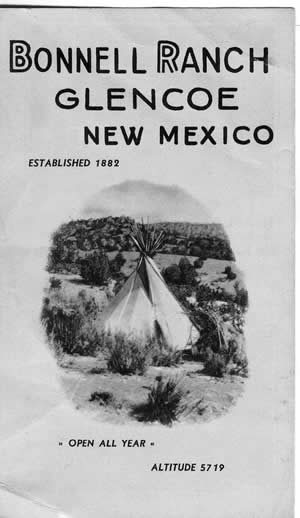
.jpg)
.jpg)
